Graphs That Give You Gains: One of the lovely curves you’re about to become familiar with.
“It depends.” I hate giving this answer, but in so many cases that’s the only one that can be given. Unlike with the coaching, when people ask questions in the comments I don’t know the person and their situation, so in order to be helpful I need to either ask a follow up question, or explain a bit of theory, and by that point the person is often no longer interested and thinks I’m just being awkward by not giving the single answer that they so desperately want to hear.
Sometimes you need to read a little theory to get the answers you want…
Why should I cut back my training volume in a calorie deficit? By how much?
Are 3 sets better than 5, or 5 better than three?
How does training experience affect optimal training volume?
How little can I get away with yet maintain my gains?
It all comes down to stress: Training is a stress that we put on our bodies to force adaptation. You need to manage stress and recovery to make optimal gains. This article provides a framework to help show you how to answer those questions.
This is a chapter from Greg Nuckols’ book, ‘The Science of Lifting’. As I was proof-reading it for him this just stood out as a section that I felt you (the discerning RippedBody.jp reader) would find useful, so I asked if I could pay to feature this here on the site. While I had my hand in suggesting tweaks to the graphs and extending it to cover calorie deficit circumstances, consider this all Greg’s work. Seriously, I hope you enjoy it – this one totally tickles my inner nerd, while still remaining practical and applicable.
Enter Greg Nuckols…
Stress: In The Gym, Out of The Gym, and How it Affects Your Program and Progress
The Conceptual Groundwork
When thinking about stress, it’s always useful to start with the General Adaptation Syndrome in mind. Very small amounts of stress won’t provoke a very robust adaptive response, but more stress increases adaptation. However, too much stress – to the point that you can’t cope with it physically or psychologically – also decreases the rate of adaptation. An important factor to keep in mind is that your body doesn’t differentiate between different types of stress to a great degree. Although the specific adaptations to different types of stress (lifting weights, a car crash, tight deadlines at work, etc.) differ, your body’s general response when it encounters and copes with any stressor is very similar for any stressor you encounter. This means (to simplify things a bit) that all the stressors in your life pool together, and dip into the same reservoir of “adaptive reserves” that are available for recovering from those stressors, allowing you to adapt so you’ll be better equipped to handle them next time. In the case of strength training, that means bigger, stronger muscles, more resilient tendons and connective tissue, and bones that can handle heavier loading.
Your body needs a certain amount of stress simply to function normally. Remove all the stressors from your life, and your body begins to deteriorate. For example, if you won the lottery and spent a year laying on the couch, watching reality TV – facing no stressors that challenge you physically or mentally – you’d be much weaker and in much worse health than you are now with some baseline level of physical and psychological stress in your life. [Greg and I seem to have very different ideas on how to best spend lottery winnings.]
Past that baseline level, further stress causes beneficial adaptation, with diminishing returns and eventually negative returns. The first input of any sort of stress tends to cause the largest beneficial adaptation, with further stress having an additive effect, though each additional unit of stress doesn’t add as much additional benefit as the first one did. However, once the total amount of stress you’re coping with (physically and psychologically) exceeds the threshold of what your “adaptive reserves” can handle, additional stress begins having a negative effect.
Here’s how this concept applies to training
The easiest way to visualize this concept is by looking at the integral of a skew right normal distribution with x-intercepts at 0 (for an untrained lifter – more on that later) and some arbitrary positive number.
Here is one such curve sketched out, with intercepts at 0 units of stress (no stress means no adaptation) and 4.5 units of stress (the maximal amount you can handle without reaching beyond your ability to cope).
(Fig. 1) THE TRAINING STRESS RESPONSE CURVE
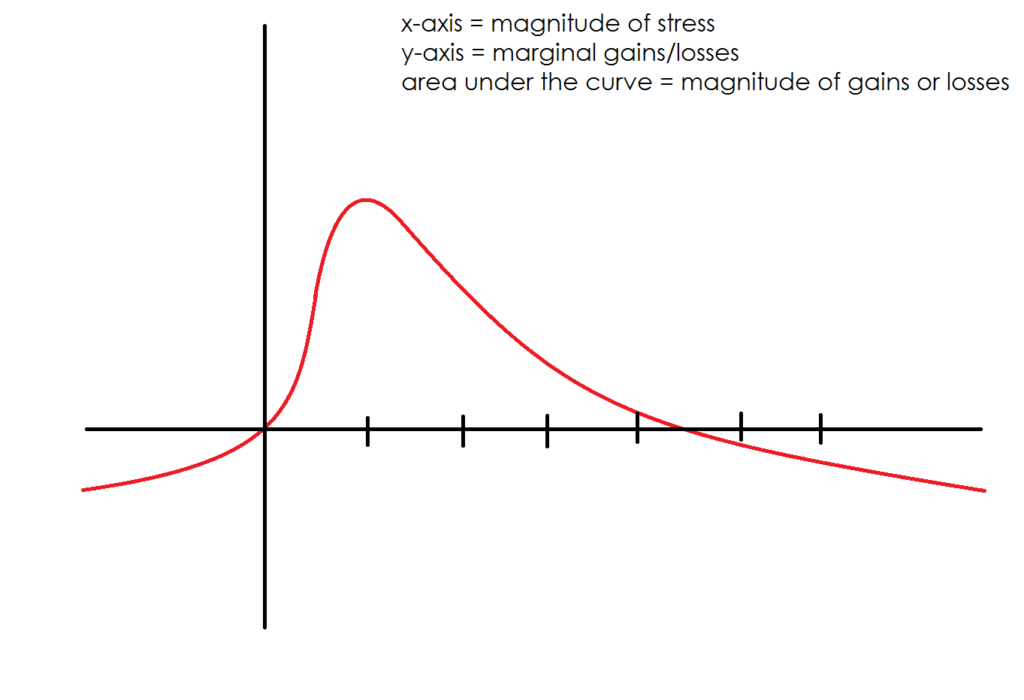
Below I’ve sketched out the integral (area under the curve) when the body is presented with 1 unit of stress. This would be a small-to-moderate stressor. The magnitude of adaptation is represented by the shaded area.
(Fig. 2) THE MAGNITUDE OF ADAPTATION FROM A SMALL-TO-MODERATE STRESSOR
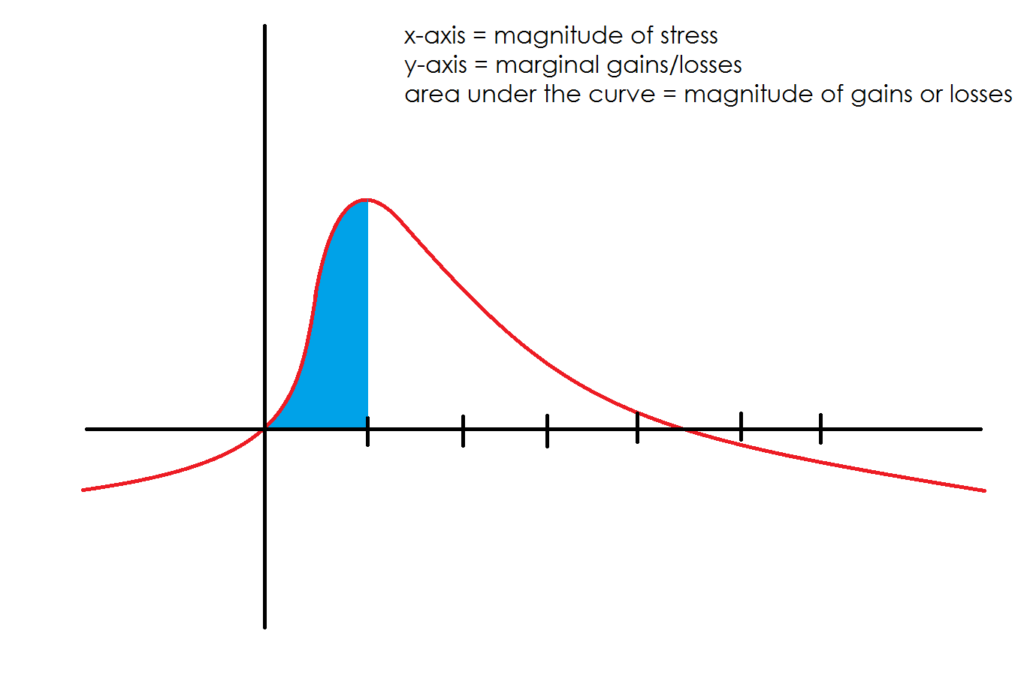
Here is the integral for 4 units of stress. As you can see, the shaded area is larger than it was for just 1 unit of stress. This means a larger adaptive response. This would be near the maximal amount of stress the body can respond to productively, and the maximal amount of benefit you could possibly get from training (maximum would be around 4.5).
(Fig. 3) THE MAXIMAL AMOUNT OF TRAINING STRESS YOU CAN HANDLE AND MAKE GAINS FROM
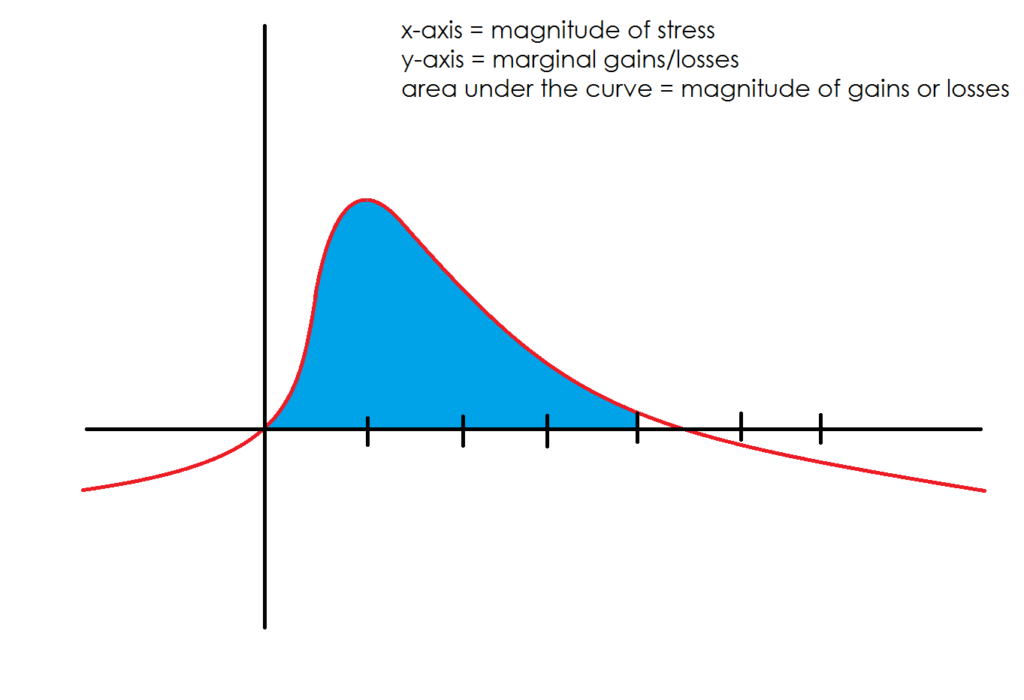
Below you see what happens when we have 8 units of stress. This represents a stressor larger than that which the body would respond maximally too. Area in quadrant 4 (below the x-axis) represents a reduction in the magnitude of the adaptive response. In this case, the area under the curve between 4.5 and 8 represents the magnitude of benefit that’s been nullified from doing too much, so that you’d get slightly more benefit from 2 units of stress than you would from doing 4x as much work.
(Fig. 4) OVERTRAINING, STEALING OUR GAINS
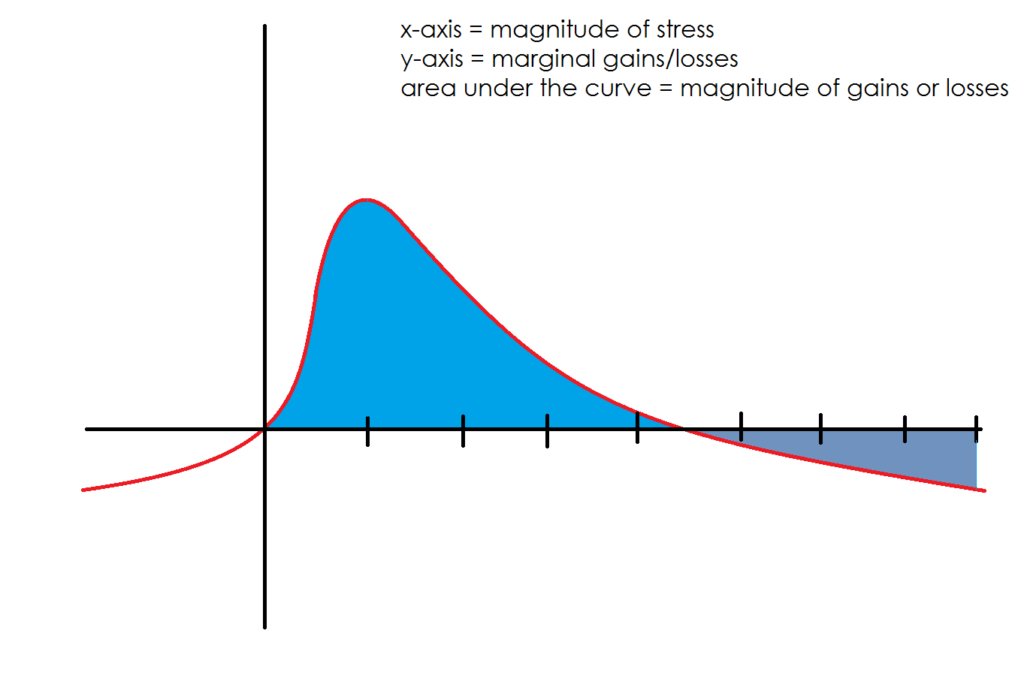
This is roughly what occurs when dealing with training factors that add stress.
So just to sum all of this up, in case you’re still a little confused about what exactly you’re looking at:
- the x-intercept on the left (for the graphs above) represents the minimum amount of stress necessary to start having a positive effect.
- the x-intercept on the right (4.5 for the graphs above) represents the maximum amount of stress the body can respond productively to.
- the positive area under the curve, minus the negative area under the curve, is the total amount of positive adaptation you get from your training.
- the curve itself represents marginal gains or losses as the stimulus increases.
Training Volume, Training Intensity, and Cardio
Let’s look at three examples: Training volume, training intensity, and cardio training.
Training Volume
James Kreiger’s wonderful meta-analysis about the effects of doing more sets in training illustrates the first part of this concept beautifully. 2-3 work sets will give you significantly better gains than 1 work set, and 4-6 sets will probably give you better gains than 2-3 sets (it didn’t reach statistical significance, but there is a larger effect size). However, there was a much larger difference between 1 and 2-3 than there was between 2-3 and 4-6. The former would represent going from maybe 2 units of stress in the graphs above, to 3 units of stress. The latter would represent going from 3 to 4 units of stress – increased gains, but not nearly to the same extent.
However, that relationship of increased work leading to increased gains only holds true to a point. Once you accumulate too much volume, you start regressing; you enter the realm of overtraining.
This is a direct message to anyone who says overtraining doesn’t exist: run a marathon every day, lift weights HARD for 4-5 hours every day, eat as much as you want, sleep as much as you want (and shoot, take whatever steroids you want), and tell me at the end of 6 months if you still think overtraining is imaginary (if you survive until the end).
That represents the curve dipping below the x-axis, and the detriments of the stress in excess of the maximal amount you’re capable of adapting to overwhelming the benefits you’d have seen from lower levels of stress.
With training volume, more is better until you reach your limit, at which point further increases don’t just fail to produce better results, but instead lead to worse results.
Training Intensity
Training intensity is similar to training volume. Research has shown that using loads of at least 60% of your max are necessary to cause robust gains in hypertrophy under normal conditions. From that point, there’s a range from about 60-85% that gives you the most bang for your buck in terms of strength and hypertrophy gains.
When you start training above 85% regularly, especially if you’re taking a lot of your sets close to failure, the benefits start decreasing. This is because training volume is priority #1, and you simply can’t handle very much training volume with 90-100% of your max. Training that heavy has its place when peaking for a meet, or if you have the rest of your program adjusted accordingly to allow for appropriate training volume, but it doesn’t allow you to simply do enough work to make your best strength and size gains year-round under most circumstances, if that’s the only intensity range you use.
To see this in practice, you can simply look around at almost every successful strength training program in existence. You’ll see that the vast majority of successful powerlifters and bodybuilders throughout the years have made the intensity range of 60-85% the bread and butter of their training, because it allows for adequate training volume without unduly increasing psychological stress; constantly training too light doesn’t give your body enough reason to grow, and training too heavy has more of the downside (mentally stressful, and doesn’t allow for adequate training volume) with very similar upsides (muscle, bone, and neural adaptations that come with strength training) to training in the 60-85% range.
Cardio Training
Doing some aerobic training will have a positive impact on your lifting, because picking up heavy stuff is an energy-intensive endeavor. If your conditioning isn’t good enough to knock out set after set, you’re not going to be able to handle enough training volume, and your recovery likely won’t be as good.
However, for a strength athlete or bodybuilder, all you’re really shooting for is an adequate base of aerobic fitness. Benefits accrue to the point that you attain that sufficient base level of aerobic fitness. However, once you start training like you’re going to run a marathon, strength and mass gains suffer.
Proper structuring of training is key here, too. It takes more dedicated cardiovascular training to build aerobic fitness, but relatively little to maintain it. Since it’s a stressor you have to account for, a training block dedicated to building more aerobic fitness necessitates reductions in lifting volume. However, once you have an adequate base (a resting heart rate in the low 60s is a good indicator), you can dial back your aerobic training to allow you to ramp your strength training back up.
How Genetics, Drugs, Training Experience, Recovery Modalities & Calorie Balance Affect Our Gains
An important thing to keep in mind with this concept is that your training status shifts the curve. As you become more highly trained, the y-intercept would become farther and farther below 0, representing the fact that it requires a certain amount of stress simply to maintain your current adaptations. If you’re untrained, no stress means no gains and no losses. With more training, no stress whatsoever means larger and larger losses – it takes more work just to maintain performance (though maintenance is considerably easier than progress).
How Training Experience Affects the Curve
Furthermore, as you become more highly trained, the apex of the curve shifts down and the curve as a whole stretches out.
(Fig. 5) INCREASES IN TRAINING EXPERIENCE SHIFT THE CURVE DOWN AND STRETCHES THE RIGHT TAIL
In non-nerd speak, this means that the total possible gains you can make decrease, the amount of work you have to do to maintain your strength increases, but the total amount of productive work you can do increases.
How Life Stressors Negatively Impact Our Gains
Life stressors can shift the curve down. The minimal amount of training stress necessary to make gains increases, the overall magnitude of adaptations possible decrease, and the maximal amount of training stress you can handle before overreaching/overtraining decreases.
(Fig. 6) AN INCREASE IN LIFE STRESSORS SHIFT THE CURVE DOWN
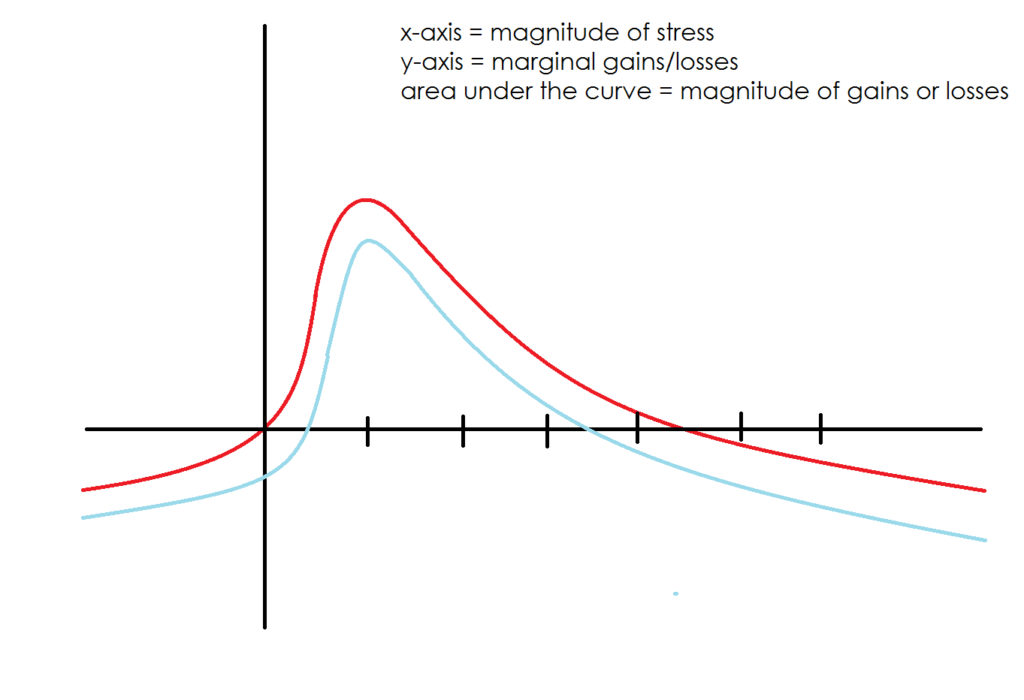
How Better Recovery Modalities Positively Affect Our Gains From Training
More attention to stress management and “recovery” modalities (sleep and meditation are two I would recommend for example) can shift the curve up, meaning beneficial adaptations to a lower threshold of training stressors, greater total possibilities for adaptation, and a higher ceiling for the amount of training stress you can handle before overreaching/overtraining. (See figure 7)
(Fig. 7) BETTER RECOVERY MODALITIES SHIFT THE CURVE UP AND OUT
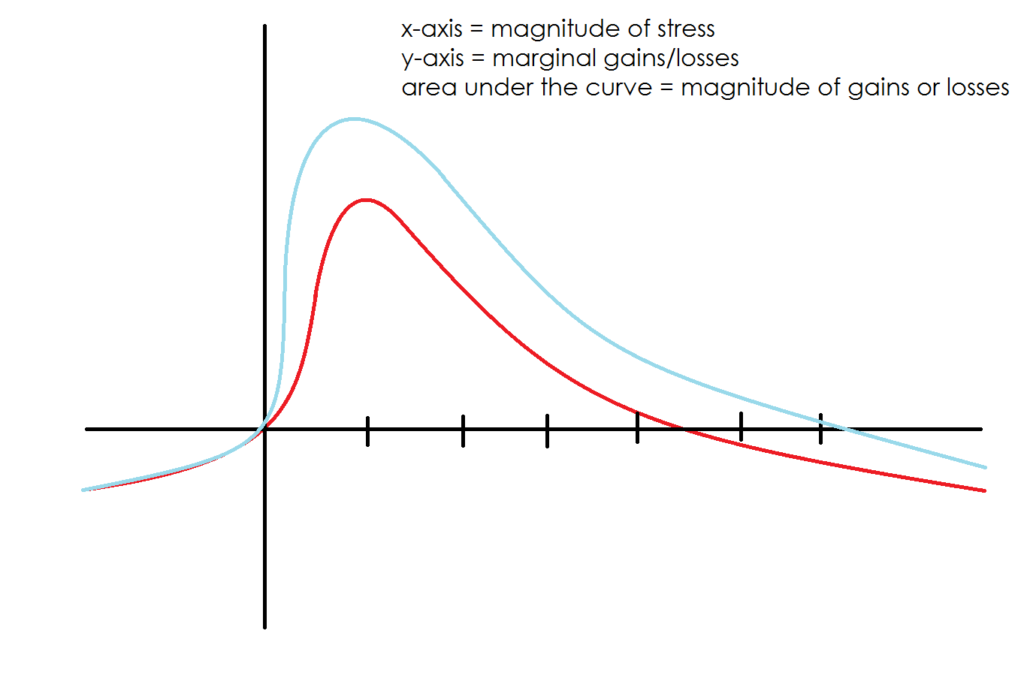
Genetic factors and steroids work in a similar manner, with better genetics/more drugs shifting the curve up, and worse genetics/fewer drugs shifting the curve down.
One final note = to make the normal training range easier to see on the graphs above, none of the curves went very far past the right intercept (when excess stress starts eating into your gains). As the stress increases further, there’s an increasingly negative effect. A bit over optimal isn’t much of an issue, more than that drives you toward overreaching/overtraining, and then past that point really bad stuff starts happening.
(Fig. 8) WHAT HAPPENS WHEN YOU THROW CAUTION TO THE WIND AND TRY TO REPLICATE A CT FLETCHER WORKOUT (Exceptionally High Volume)
How Calorie Deficits Negatively Affect Our Training Response, How Surpluses Positively Impact It
[From here consider the article is a joint-effort. I hijacked Greg’s conceptual model to illustrate a point I wanted to make about calorie balance affecting training. – Andy]
This concept is also crucially important for planning your training in a calorie deficit versus a surplus. A calorie deficit is a stressor that competes for those adaptive reserves by itself, meaning less are left over to respond to the stress of strength training. Add to that the simple mechanistic fact that building new muscle requires energy, and when you’re in a calorie deficit, you have less energy left over to build muscle after the energetic needs for survival are taken care of. These things shift the curve down.
Let’s look at how energy balance affects the training stress response curve of the novice trainee:
(Fig. 9) HOW CALORIE BALANCE AFFECTS THE GAINS OF A NOVICE TRAINEE
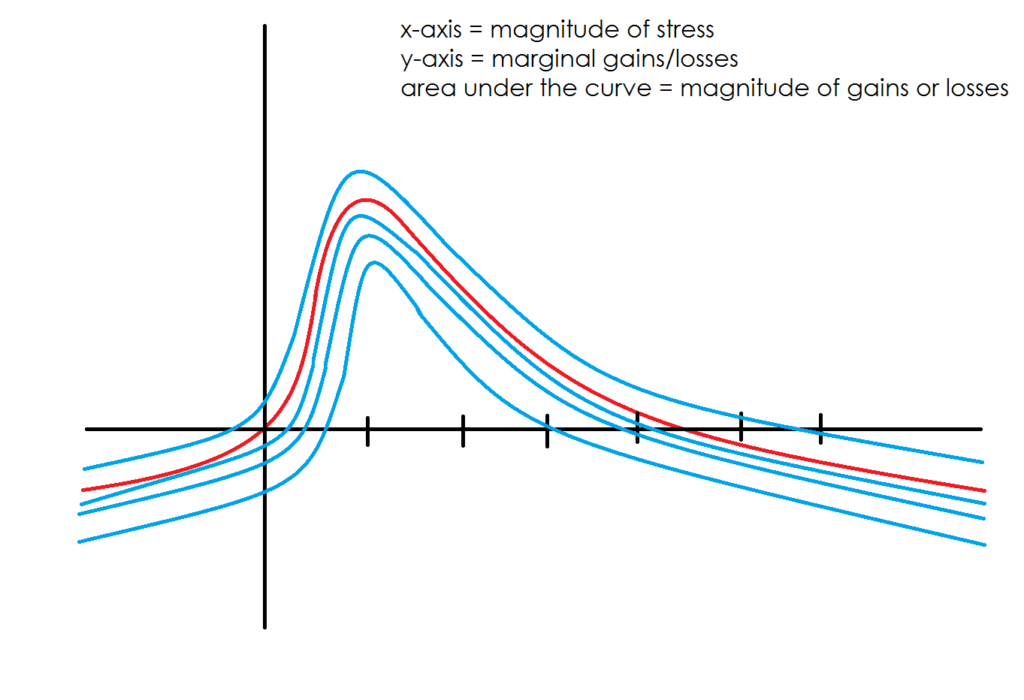
In the graph above, the red curve may represent maintenance calories. The blue curves below it represent deficits of different magnitudes, and the blue curve above it would represent a surplus.
We can see that even for the novice trainee, as the calorie deficit increases, the y-axis intercept drops further and further below zero. – Training is required in order to maintain muscle mass.
The takeaway: in a deficit, you can’t gain muscle at the same rate as you can in a surplus, and you can’t handle and benefit from the same level of training volume – it takes less total work to dip below the x-axis and migrate from productive work to counter-productive (not just unproductive) excessive work.
In a surplus, those factors are exactly reversed. Eating a surplus of calories is an inherently stress-reducing activity (a major reason so many people stress eat – eating extra when you’re stressed helps you cope physically and psychologically with the stress), and leaves more energy left over to be used to build muscle after essential life-maintaining functions are taken care of. For this reason, you can and should increase your training volume when in a surplus – you can handle a significantly higher workload to build strength and muscle at a faster rate.
Now let’s consider how a deficit affects more advanced lifters:
Recall from figure 5 that an increase in training experience shifts the curve down. With a calorie deficit, the response curve shifts down further.
What this means is that the training amount required in order to not regress increases, the overall potential for adaptations is greatly reduced, and the amount of training that can be handled before over-training occurs (and thus marginal losses have potential to accrue) is lower (though you will notice still higher than for the novice trainee). In many instances, for an advanced lifter, simply maintaining strength and muscle mass during a deficit may be the most you can hope for – the area below the x-axis on the left equaling the maximal positive area under the curve.
(Fig. 10) HOW CALORIE BALANCE AFFECTS THE GAINS OF A HIGHLY EXPERIENCED TRAINEE
If we shift the curve down once more to consider a highly advanced trainee, we would see that the margin for getting positive adaptations to training while in a calorie deficit are minimal, and the margin for error with setting the training stimulus is small – too much or too little and regression will occur.
Concluding Thoughts
In order to make the most of your training efforts:
- Eat well.
- Sleep well.
- Do your best to minimize stress in your life.
- Accept that if your primary goal is fat loss, you’ll need to be in a calorie deficit, and that does mean a reduced rate of gains. You won’t necessarily recover from the same level of training anymore, and you may very well need to reduce it in order to not shortcut your own efforts.
- Do not seek a one size fits all routine with your training. No one can tell you where you are on the curve – you have to play with it and see how you go.
- Don’t do drugs but have a mindset that you’re on them. – Believing in yourself will shift your gains curve up.
****************
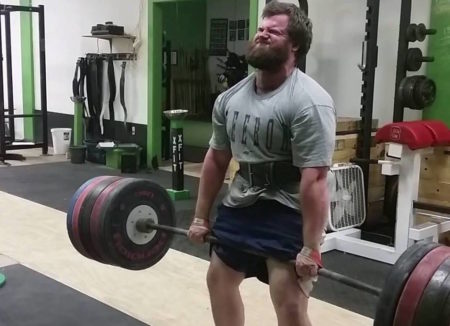
Greg’s book, ‘The Science of Lifting’ is packed full of chapters like this. It’s perfect for the trainee that has 6 months of real lifting under their belt, helping them to conceptualize things so they can answer their own questions and become independent.
I’m not sure whether I am letting my inner geek get the better of me here, but I feel it is the best book I have ever read on training, period, and I’ve already been recommending this to people for months.
You’ll find it bundled with an excellent but less geeky companion book, ‘The Art of Lifting’ which is perfect for the beginner and something I plan on sending to my 19 year old self when they invent the time machine. They are available here. (Not an affiliate link.)
Both Greg and I are available in the comments if you have questions. Thanks for reading!
Related guides:

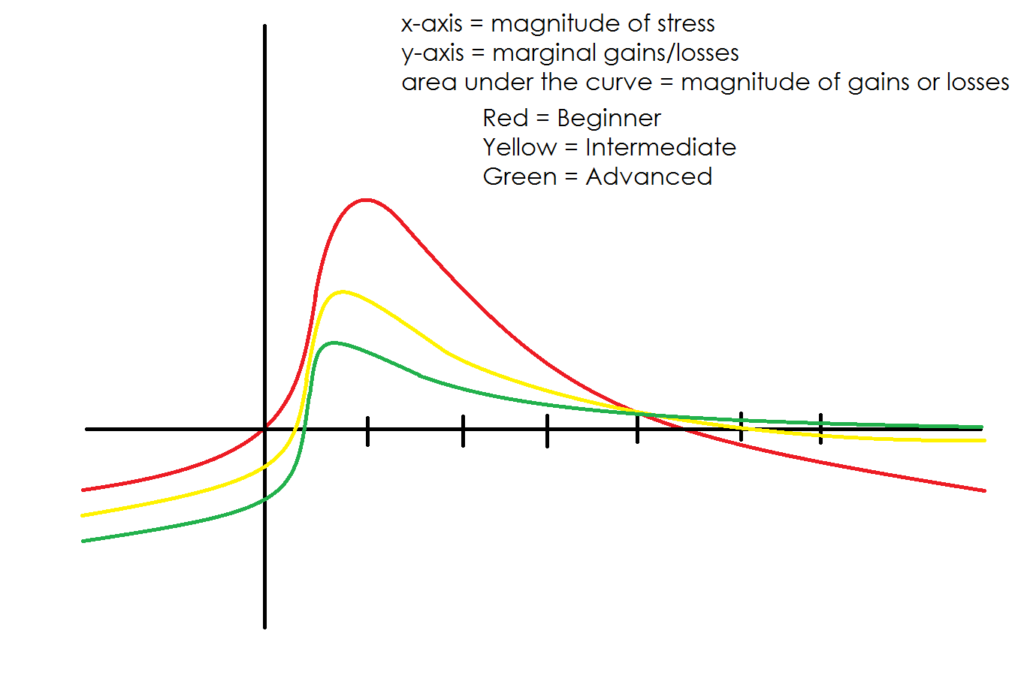
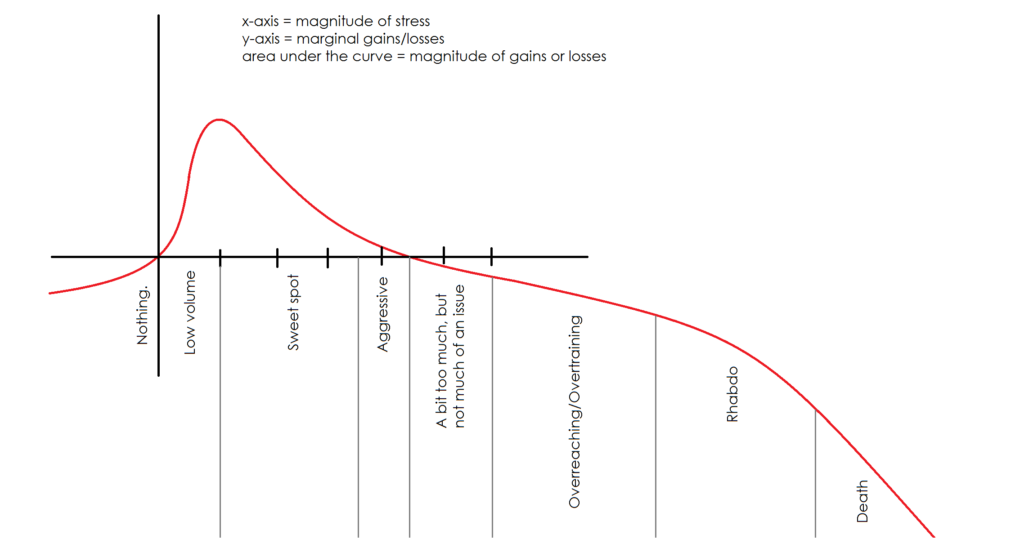
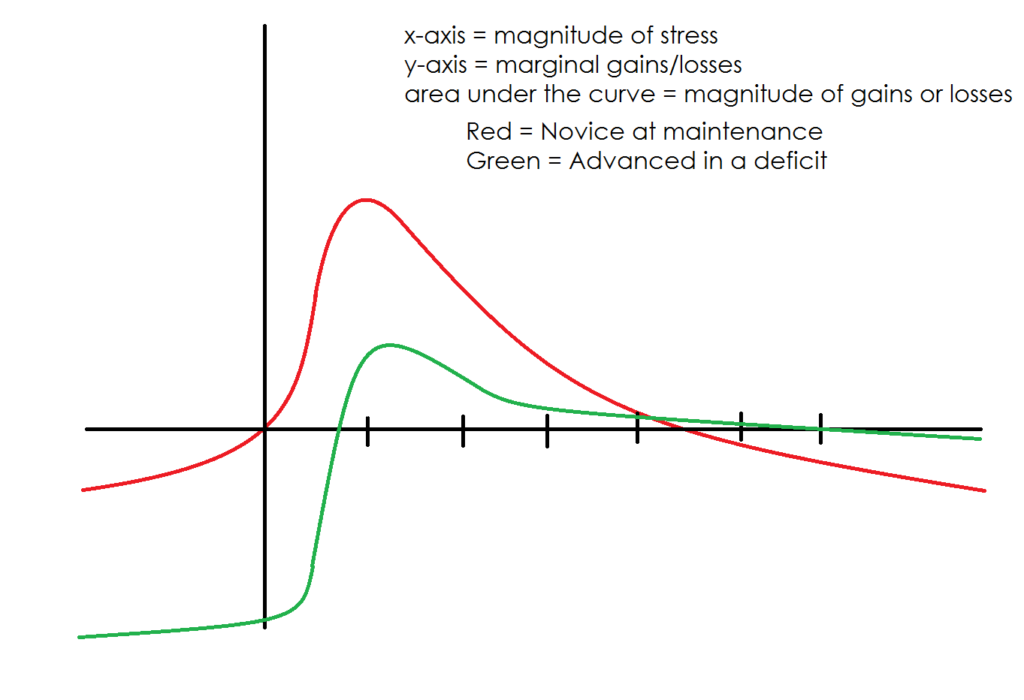
Privacy policy.